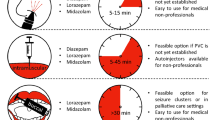Summary
Steady state plasma levels and clinical effects of disopyramide have been compared following administration of standard capsules and controlled release (CR) tablets. Nineteen patients (29–70 years) with atrial or ventricular arrhythmias were treated for two weeks with disopyramide capsules 200 mg t.i.d. and then with CR tablets 300 mg b.i.d. for 14 weeks. After treatment either with capsules or CR tablets, plasma concentrations of disopyramide and its metabolite N-deisopropyldisopyramide were similar within 1 dosage interval. Maximum and minimum concentrations of the parent drug were 10.1±0.9 µmol/l (mean ± SEM) and 5.7±0.5 µmol/l with CR tablets, and 10.2±0.5 µmol/l and 5.6±0.5 µmol/l with standard capsules. The bioavailability of disopyramide was the same after capsules and CR tablets. Disopyramide, independent of the formulation, produced good antiarrhythmic effects. The side-effects reported on questioning were mainly of the anti-cholinergic type and there was no significant difference between the formulations with respect to their incidence, type or severity. Of 16 patients who stated a preference for one of the dosage forms, 11 prefered the CR tablets. The study confirms the good antiarrhythmic effect of disopyramide and shows that the CR preparation permits twice daily administration of disopyramide.
Similar content being viewed by others
References
Härtel G, Louhija A, Konttinen A (1974) Disopyramide in the prevention of recurrence of atrial fibrillation after electroconversion. Clin Pharmacol Ther 15: 551–555
Deano DA, WuD, Mautner RK, Sherman RH, Ehsani AE, Rosen KM (1977) The antiarrhythmic efficacy of intravenous therapy with disopyramide phosphate. Chest 71: 597–606
Sloman JG, Hunt D, Vohra J, Dowling J, Duffield A (1977) Oral disopyramide in the management of cardiac arrhytmias. Med J Aust 1: 176–178
Luoma PV, Kujala PA, Juustila HJ, Takkunen JT (1978) Efficacy of intravenous disopyramide in the termination of supraventricular arrhytmias. J Clin Pharmacol 18: 293–301
Camm J, Ward D, Spurrell RAJ (1979) The effect of intravenous disopyramide phosphate on recurrent paroxysmal tachycardias. Br J Clin Pharmacol 8: 441–449
Vismara LA, Mason DT, Amsterdam EA (1974) Disopyramide phosphate: clinical efficacy of a new oral antiarrhythmic drug. Clin Pharmacol Ther 16: 330–335
Smith WS (1975) Clinical studies of Norpace (part I). Angiology 26 [Suppl 1]: 124–131
Oshrain C, Arif M, Laidlaw JC, Cook WR, Willis P (1976) A double-blind comparison of disopyramide phosphate and quinidine sulphate as antiarrhythmic agents. Report from Scientific Exhibit 40th Scientific Sessions. American Heart Association. Miami, Florida, November 15–18
Jennings G, Model DG, Jones MBS, Turner PP, Besterman EMM, Kidner PH (1976) Oral disopyramide in prophylaxis of arrhythmias following myocardial infarction. Lancet 1: 51–54
Zainal N, Griffiths JW, Carmichael DJS, Besterman EMM, Kidner PH, Gillham AD, Summers GD (1977) Oral disopyramide for the prevention of arrhythmias in patients with acute myocardial infarction admitted to open wards. Lancet 2: 887–889
Graffner C, Lagerström P-O, Lundborg P, Rönn O (1981) Relative absorption of disopyramide following acute administration of standard capsules and controlled release tablets, determined by liquid chromatography. Clin Pharmacol Ther 19: 414–420
Forsell G, Graffner C, Nordlander R, Nyquist O (1980) Comparative bioavailability of disopyramide after multiple dosing with standard capsules and controlled-release tablets. Eur J Clin Pharmacol 17: 209–213
Aitio M-L, Mansury L, Tala E, Haataja M, Aitio A (1981) The effect of enzyme induction on the metabolism of disopyramide in man. Br J Clin Pharmacol 11: 279–285
Landmark K, Storstein L, Larsen A (1979) Disopyramide plasma levels in cardiac patients on maintenance therapy. Acta Med Scand 206: 385–389
Meffin PJ, Robert EW, Winkle RA, Harapat S, Peters FA, Harrison DC (1979) Role of concentration-dependent plasma protein binding in disopyramide disposition. J Pharmacokinet Biopharm 7: 29–46
David BM, Madsen BW, Ilett KF (1980) Plasma binding of disopyramide. Br J Clin Pharmacol 9: 614–618
Gatley MS (1968) To be taken as directed. J R Coll Gen Pract 16: 39–44
Hussar DA (1975) Patient noncompliance. J Am Pharm Assoc 15: 183–190 and 201
Author information
Authors and Affiliations
Rights and permissions
About this article
Cite this article
Arnman, K., Graffner, C., Rikner, L. et al. Plasma concentration of disopyramide given as capsules and controlled release tablets. Eur J Clin Pharmacol 24, 199–203 (1983). https://doi.org/10.1007/BF00613817
Received:
Revised:
Accepted:
Issue Date:
DOI: https://doi.org/10.1007/BF00613817




